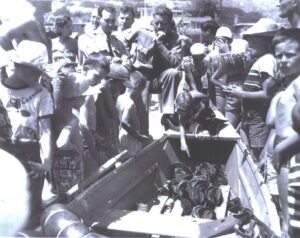Not merely decoration

For a marine mollusk, abalone are exceptionally well traveled. Often found far from the ocean, their shells garnish the homes of many who find their radiance a beautiful reminder of the coast. While many are familiar with their shells, fewer know about the creatures that inhabit them, but by learning more, abalone can be heralds of many important stories, about the wonders of biology, the decline of wild animals, and the importance of conservation.
There are seven different species of abalone found in California and, like many coastal organisms, they have adapted to live in a turbulent environment. Their body is comprised of a rough shell and a broad muscular foot, which clings to the rocks. While living this rocky life, they primarily survive by feeding on drifting algae. Under ideal conditions, an abalone can survive decades; however, they suffer mortality from disease, predation, harvesting, and storms. Over the last century, due to an increase in these factors, abalone populations have been in decline throughout the state.
The decline of abalone is largely the product of harvest and disease. Abalone harvest started in the late 1800s and primarily occurred in the intertidal zones. In the early 1900s, harvest increased offshore, as intertidal populations became depleted. As scuba equipment improved, more gained access to offshore abalone, further decreasing populations. During the mid-1900s, Crystal Cove was a popular spot to harvest abalone, a hobby taken up by covites Bob Davick and Ken Steen. Their hauls were so large that they would attribute some of their catch to the kids who came with them, in order to meet legal limits. In the mid-1980s abalone were hit with an additional pressure, disease, which caused them to shrink and fall from rocks. Harvest continued, with diminishing returns, until 1997, when most abalone take was officially ended. The combined pressure of harvest and disease crashed populations across California, leading to a need for protection.

Today, the recovery of abalone populations is the primary goal of conservation efforts. By ending large scale take, hopefully abalone populations can rebound. One method to bolster these efforts is to grow abalone in tanks and then release them into the wild. To be successful, scientists must know the ideal conditions (size, weight, strength) for an abalone to survive in the wild. This summer, Crystal Cove Conservancy is partnering with UC Irvine researchers to help answer this question. Come by Cottage #22 our Park & Marine Research Center every Wednesday until the end of August and help us feed and measure abalone. Together we can begin to answer this “crushell” question so abalone can be successfully restored to their rocky communities.
